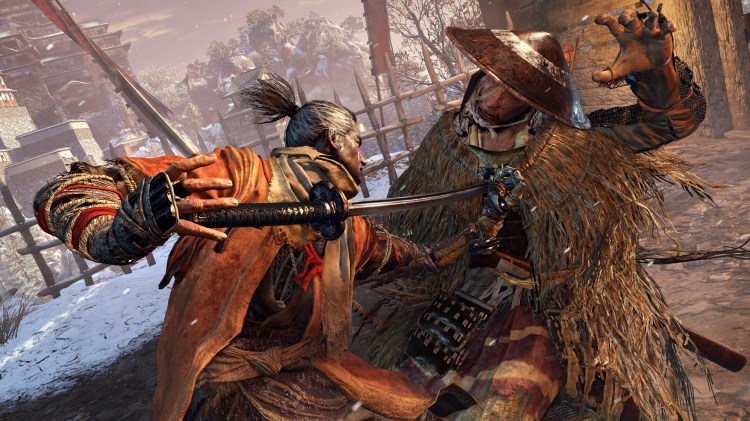I’ve never played deep into a From Software game before. I’ve probably played 10 hours of Bloodborne and 2 hours of Dark Souls, and that’s it. So let’s clarify what my purpose is here.
I’m here to see if Sekiro: Shadows Die Twice can click for someone who does not have the reverence for the “Soulsborne” games.
Sekiro: Shadows Die Twice is out now on consoles and PC, and it’s definitely an evolution of the From formula. And after getting over an early hump, I ended up loving Sekiro’s fast-paced action.
Check out our Reviews Vault for past game reviews.
June 5th: The AI Audit in NYC
Join us next week in NYC to engage with top executive leaders, delving into strategies for auditing AI models to ensure fairness, optimal performance, and ethical compliance across diverse organizations. Secure your attendance for this exclusive invite-only event.
What you’ll like
Great fights
In Sekiro, you play as a shinobi called Wolf. As his job title suggests, he uses sneaky ninja skills to avoid or minimize encountering enemies head on. But this is still a From game, and that means that combat is still central to its mechanics.
But don’t go in expecting duels in Sekiro to go down like Dark Souls. This game plays a lot more like Ninja Gaiden for the Xbox. It is closer to a character-action game than any other previous Soulsborne release.
You can quickly dodge or jump into the air to evade attacks. If you time it right, you can jump on an enemy’s head and then immediately swing down with your blade.
I think this makes the game more accessible, but From is still going to From. Attacks still have animation priority. If you started a sword attack, you’re going to have to go through most of it before you can cancel out of it to dodge. But even when you commit to a swing, it closes the input window for only a brief moment. That feels pretty good until you get too overconfident and an ogre one-hits you into a ravine.
I LOVE VIDEO GAMES #Sekiro pic.twitter.com/ufAyoXMw8z
— Grubb (@JeffGrubb) March 20, 2019
Sekiro treats sword attacks as deadly. So most fights come down to breaking an opponents posture to give yourself an opening for a killing blow. Basic samurai-style villains fill out the early stages. They are easy to take out by repeatedly attacking or by parrying.
And then bigger, more challenging enemies punctuate each area. Unlike the standard samurai, the stronger enemies require two killing blows. They are also require a lot more work to wear down their posture.
But unlike the standard creeps, miniboss and boss-level enemies do not respawn when you rest at the save points.
Stealth gives you a better chance
But you don’t always have to fight. Wolf has stealth abilities that enable him to stay hidden in grass and even in plain sight with certain powerups. This option gives you a chance to thin the enemy ranks before you have to fight.
The stealth is powerful enough that you can even instantly do one of the fatal blows on a powerful enemy that requires more than one. This is crucial to survival and you will want to approach almost every situation with the goal of finding a way to sneak up behind the most dangerous foes.
And I really love this aspect of Sekiro. It feels like developer-approved cheesing. I’m not good enough to fight 10 enemies in a row and then a miniboss, but I can sneak around and take them out and then take away half of the miniboss’s life in with a surprise attack.
What you won’t like
It deals in two emotions: Anger and confusion
Sekiro has a lot that I like, but I’m still spending most of my time with it feeling angry, confused, or both. I’m not very deep into the story or progression, but I’m completely lost.
Here’s a list of things that I don’t know:
- I don’t know what my current objective is.
- I don’t know where I’m going.
- I don’t know where I’m at.
- I don’t know if I’m heading in the right direction.
- If I’m going in the wrong direction, I don’t know where the alternative routes are.
- I don’t know if I’m missing any powerups.
- I don’t know how to spend skill points
- I do know that something bad is happening because I’m dying too often, I just don’t know exactly what that bad thing is.
I am confused. And when I get to an especially tough enemy that takes literally dozens of attempts, I am often also angry.
And here’s the thing: I don’t mind feeling angry and confused. Those are valid human emotions that games should sometimes make you feel. And while I think this is sometimes a negative, in the end, Sekiro’s highs earn those feelings.
The issue is that, in Sekiro, I sometimes feel like I’m doing trial and error until I learn the right dance steps. And that’s not always the best feeling. But as you learn more about how the dancing works, that satisfaction increases throughout the game.
Conclusion
I love Sekiro. It’s one of my favorite games of the year. I’m happy that I can now consider myself among From’s fans.
Getting through Sekiro feels like an accomplishment. But it’s not just about how satisfying it is to beat. The process of figuring out each encounter is enthralling. If you bounced off every From Software game up to this point, I think it’s worth coming back and trying once again.
Score: 90/100
Sekiro: Shadows Die Twice is out March 22 for the PC, PlayStation 4, and Xbox One. The publisher provided GamesBeat with a digital PC code for the purposes of this review.


